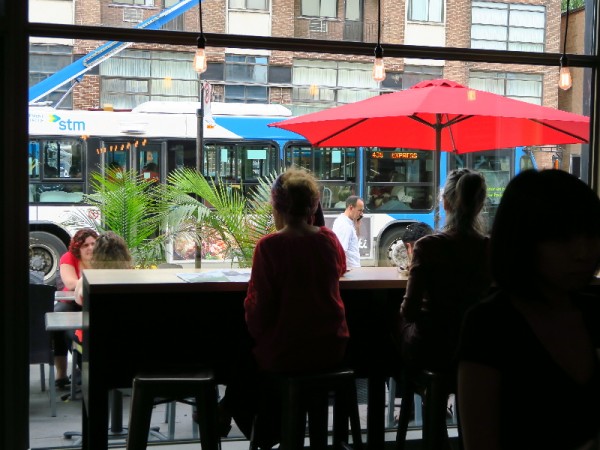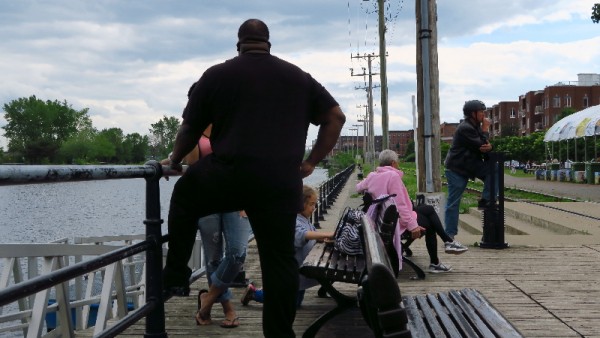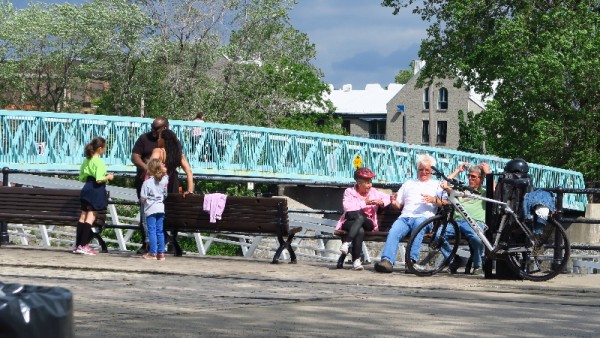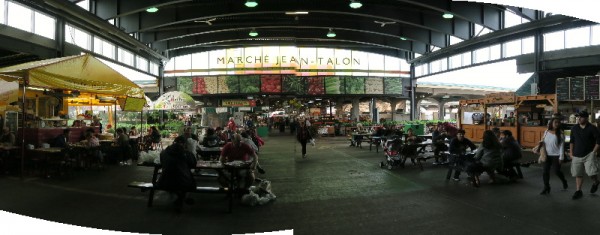General considerations
Summer is finally here as a time of possibilities after a winter of constraints, when hanging out, as a mindset defined by being open to possibilities, leads us to search for live places made livelier by the clemency of summer.
The feature image captures perhaps the spirit of it, as benches surrounding a duck pond in Montreal Botanical Garden are filled with music and nature lovers … just hanging out.
What constitutes hanging out?
Is it something like “to be away for things like coffee-hanging out” as put by my colleague and friend the cultural geographer Falken Forshaw?
Is it just being out in public with nothing particular on one’s mind, but to be with some friends at some favorite place… and see what happens?
Conventionally speaking, one “hangs out” alone or with people one likes, or appreciates, with the possibility of doing nothing, or something more specific, depending on the place, the people and the circumstances.
Where to hang out?
The answer to that question can be a favorite “hangout” or it can just be a type of place that attracts us for its “hanging out potential”, such as:
- Place: I see hanging out in a rather circumscribed space next to, or part of, a larger one, and this holds true for indoor or outdoor situations. I see the presence of evocative props such as seats, tables, piles of newspapers, fences, lamp posts, trees, doors, windows, pathways, bodies of water, parapets, etc. all suggesting possibilities for passive observation or sympathetic contact sought by hanging out.
- People: The presence of people in a place, whether gathering around activities and props, or just passing by, is essential to defining the possibilities of spontaneous contacts that are subsumed in hanging out. Assuming that one’s interest in the place is shared with the people present there, one can say that the more varied the age, gender and grouping of people, the best is the place to be hanging out in.
- Circumstance: Being out means being exposed to weather and social circumstance. A bench, booth or counter is not the same as a street corner, yet it is clear some would prefer one or the other for hanging out. Being familiar with, or being a stranger to the place, can also affect one’s motivation to hang out, and the duration and the nature of the social experience it provides.
All of these elements can be found in the image below where, on the one hand, chess players seem to have found their preset hangout under the vaulted roof, and on the other, the lone businessman with his satchel lost in thought while sitting at a picnic table, and the elderly couple taking the air while, by just being there, enjoying the action around them and are probably open to possibilities of contact with others attracted to the edge of an old industrial canal turned into a linear park.

Exploring hanging out
Where do we hang out in summer in the city? What do we appreciate as context to this activity … as necessary focus or props? Does hanging out preclude any other “activity” or can it be an aspect of it? Does it preclude doing it with others?
I will ground my exploration of the question on specific situations and avoid, for lack of experience, treating the relation of hanging out to the digital connections with others wherever they may be.
The coffee house
A personal hangout

The distinctive attraction of this café-bakery is naturally the bread and pastry products to take home or consume on site whether on the front and rear terraces or the main room with tables and chair in the rear of the establishment … or sitting at a couple of counters.
I prefer sitting at the front counter, shown above, with its stools facing the street action while near the coffee making station. There is always someone working on crossword and Sudoku puzzles that can act as “social lubricants,” just as there is always a discussion between customers and the baristas about choice of drink and food.
I rarely stay longer than one hour, drifting in and out of my concentrated puzzle work to look at the traffic, check who is entering and leaving, eavesdropping on the latest neighborhood news, checking the action on the street and sidewalk or indulge in some chit chat with a friend who may be joining me or in whose company I came with.
This hanging out is highly colored with information gleaning by simply looking and listening, as road work or building repairs is always going on, as the crowd changes according to the school and university schedules, and as the clients age and gender will affect the possibility and nature of exchange … all of this building up the social texture of local public life.
Klatching with a good friend

A cultural institution of sort is this coffee house that offers its walls to artists and its space to musicians.
Nostalgic for a near by defunct movie house that used to harbor these activities, a good friend and I have chosen this place for our periodic klatches to discuss our photographic work, the “geist” of the time, our immigrant experience, etc.
The klatch has developed its own ritual over time, anchoring the hanging out so to speak, as we start by choosing a table up front and ordering coffee or tea, we then put on the table a camera, take stock of the people around, the art on the walls and the scenery through the generous windows, and perhaps take a few shots.
As the place went through various ownerships the set up of the place has gone through minor changes but remains basically the same with mostly business people and young mothers with children in the back lounge, working stiffs and students in the main area with its rows of tables and wooden chairs, and the mixed bunch of characters around us on the raised corner platform sitting in fifties armchairs.
After coffee and the few shots with our cameras we settle for the classic sandwich and juice, put out our notebook and pen and get on with the klatch proper, which has the habit of taking us anywhere from our places of origin, into any subject from our teaching experiences, our growing up, our next photo exhibition, always with the sense that these things underpin what living is about, good or bad.
We close the klatch within a couple of hours with a stop at the local second hand bookstore, two blocks down the street, before we shake hands and say “until the next Shaika,” that is the name of the coffee house, and short for “to our next hanging out”.
Strip mall blues
Displacement

As mentioned in a previous post any commercial strip will usually reflect the social and economic profile of a neighborhood.
As changes in tenancy occur in a strip mall, whole patterns of hanging out are often displaced and with them a whole ambiance is modified.
The three little steps leading to an indoor terrace type of arrangement have modified the essence of what used to be a sidewalk terrace, with tables at mall level outside of the old coffee shop. The new chain coffee shop has a standard fast food set up incorporating a large fare display and ordering area with a waiting line spilling onto the sidewalk where the previous terrace used to be.
These three little steps make difficult the impromptu use of the new terrace arrangement excluding people in wheelchairs or families with baby carriages forcing these to eat out on benches located here and there along the mall.
(Note: the three little steps take up the slope of the site dating from when the strip mall was an open affair, a slope that was kept by necessity when the strip mall was enclosed.)
The “blues” come from recalling the ease with which one used to access the previous coffee shop set-up as habitués would hang out at the outside tables, as the owner and his wife would welcome them and as choosing a table was a seamless affair of looking through a three tiered placement of tables: outside on the sidewalk for the habitués, inside the main room for privacy and in between near the serving counter for people alone.
At the water’s edge
The wait

Looking for a place to observe people hanging out, I headed for the edge of the old industrial canal Lachine now bordered on one side with old buildings turned into condos and a railroad track overgrown with grass waiting for its fate to play out, while on the other side a linear park and bike trail buzzed with traffic generated by the bike crowd and the residents of new housing development … a foot bridge tying the two sides (see image below)
That is what I was seeing sitting on my bench while next to it a family was enjoying ice cream (the mother); push ups on the handrail (the father) and a coloring book (the daughter). Note the alternate facing of the benches.
Further down, a bike outfitted couple, minus the bikes, was waiting for the bikes to return.
I wondered: Had I missed something? Is this hanging out or are they waiting to get back onto something that was interrupted?
The story

The bike was eventually returned to the couple with what looked like a fish story told by the bike borrower and, next bench over; the family was brought up on the candid camera situation set up a few yards away. Apparently, in both cases, their wait was for this kind of information update.
No idle pensive folks here as the story telling seemed to indicate … the wait in both situations was just a circumstantial pause in an afternoon outing to the canal water’s edge.
The benches had brought all of us in relative proximity, too far for any serious eavesdropping but for the breeze born babble.
Discussion
One can safely say that hanging out is a matter of mind set interacting with the physical and social environment and, as such, is essentially an experience that is not an easy matter to observe in others, except maybe for its territorial expression.
If so, how to find what in a place attracts hanging out? A possible answer is: in finding out what does not, territorially speaking, discourage it!
Allow me, in conclusion, to apply this hypothesis to the great hall at the Montreal Jean-Talon public market shown below:

Located at the crossing of the main axes of the market, the great hall is surrounded by eateries with their own sitting arrangement reserved, explicitly or implicitly, for the consumption of food bought on site … no squatting there!
What to make of the picnic tables placed in the hall?
Since the market is not, a priori, a place for picnicking, they could have just as easily been replaced by benches for sitting except for one thing: compared to the restrictive spacing a bench produces, a picnic table can be squatted easily by: one large group, two small ones, four individuals or a mix of these in sets of people waiting, hanging out, having coffee and crumbs, surfing the web, etc. as can be observed in the image.
This particularity is central to my hypothesis i.e. that the territorial flexibility inherent to the picnic tables in this setting, while it does not necessarily encourage hanging out, definitely does not discourage it.
As such, therefore, the picnic tables can be attractive to a hanging out mind set, without specifically determining it; framing well with the ephemeral, opportunity based, dynamic nature of the hanging out experience.
All photo credit Maurice Amiel
